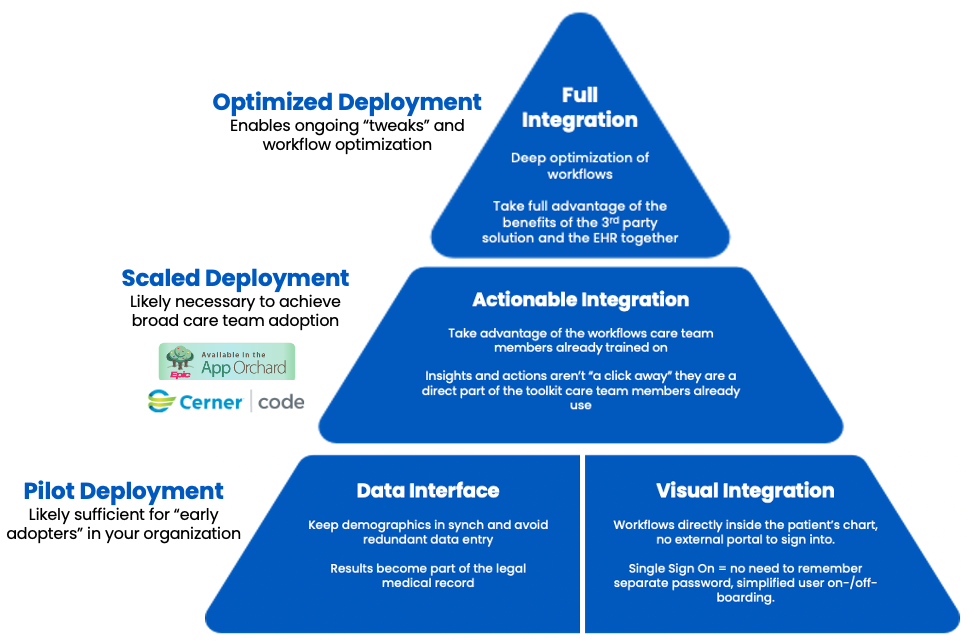Not all integrations are created equal

Clinicians, CIOs, and virtually every person in a decision-making position in a health system is courted multiple times a week by third-party solution developers with amazing products to help them with some of their most pressing problems.
For more than two years, the public health emergency has necessitated a lot of rapid-fire pilots and launches, and while the early results were great, to scale these programs health systems are now looking for solutions and approaches that can integrate deeply inside their enterprise electronic health records (EHR). Deep EHR integration makes solutions much easier to use (reduced training time), hard to forget about (more useful), and actually saves teams time (return on investment).
EHR integration, like so many terms in our industry, has come to mean so many things that it almost doesn’t mean anything. So what is EHR integration? This question is extremely important. According to one study about clinical decision support (CDS), literally 0 percent of CDS interventions succeeded when they weren’t delivered automatically in the clinician workflow. By contrast, the same study showed that 75 percent of those interventions succeeded when they were automatically presented in clinical workflow. Workflow integration comes in a variety of flavors, with the value of that integration typically proportional to the depth of integration.
Interfaces – Tried and true but insufficient
A somewhat old-school definition of integration is maybe more appropriately called “interfacing.” Ever since the late 80s/early 90s (or “the late 1900s” as I’ve started hearing it referred to), interface engines have been available and are still used by a lot of modern solutions for “integration.” The typical implementation pattern is an outbound HL7 message to facilitate an order, and an inbound HL7 transaction to receive results. There are numerous challenges with this approach including forcing clinicians to choose between staying in their EHR workflow vs. taking advantage of the advanced functionality of the add-on solution, a loss of fidelity of the information being managed in the external system, and two systems in which redundant information is being managed.
Visual integration – A step closer
Visual integration is the lightest-weight form of integration. iFrames, SMART apps, and “widgets” are all common technologies that come to mind when describing visual integration. Essentially, this is when you take one application and layer it as a self-contained component inside another application. This ideally includes a single sign-on function so the person signed into the main application doesn’t have to sign into another widget on their screen.
Actionable integration – Blurring the lines
With results interfaces and a visual integration of the external application for, say, a remote patient data solution, the clinician can navigate to that solution to review data and interact with it, as well as have the data available as part of the legal medical record. The challenge with stopping there is, how does the provider know when to go look at it? This solution could be running advanced analytics on the captured data, but if the provider forgets to click into that tab of their EHR to load the solution, it’s happening in a vacuum. By taking integration beyond the visual and integrating with the key “hooks” in the EHR such as secure messaging pools and EHR-alerting functionality, physicians and the extended care team can begin managing by exception, knowing when a patient needs attention without having to refresh a dashboard or build complicated flowsheet logic in the EHR.
A simple example here would be if a third-party remote patient monitoring solution like the Validic® Impact application observes a patient with a series of out-of-range blood pressure values. Rather than waiting for a clinician to log into the EHR and review this information, the Validic solution initiates a trigger by pushing a notification into the EHR.
Full application integration
Lastly, we come to full application service/workflow integration. This is where an existing clinical application builds workflows using services or application programming interfaces (APIs) to create their own workflow using the smarts of a third-party system behind the scenes. The benefit of this approach is that the integration is truly seamless; users don’t know (or need to know) that they’re using services from a variety of different vendors or applications.
For example, one of Validic’s clients has created their own patient panel worklist for care managers that is 100 percent their own application workflow, even though it’s being fueled by the data and insights generated by Validic. Another Validic client has developed their own patient-facing mobile app, using Validic’s platform as the backend for the patient experience with EHR Data, visual, and actionable integrations.

At Validic, we started from the ground up as a platform company and strongly believe that all of these integration options must exist together to enable the right strategy for each organization. If you’re early in your project and will only have a few users, a visually-integrated mode might make the most sense to get started. But, you need the confidence and assurance that your investment will scale with you; as the number of users goes up, the importance of deeper integration does too. Our team’s experience has shown that once you get beyond a pilot with virtually any third-party clinical solution, having options to integrate the data, initiate actions in native EHR workflows, and even building your own native workflows with our services backing those workflows is critical.
At a time when physician burnout is higher than ever and organizations are facing nursing shortages everywhere, it’s important that new technical solutions help solve this problem rather than adding to it. And, as digital health solutions and remote monitoring programs scale within an organization, deeper integration within existing systems becomes increasingly important.
Learn more about Validic’s fully integrated remote care solution. Available as a standard integration through the Epic App Orchard.